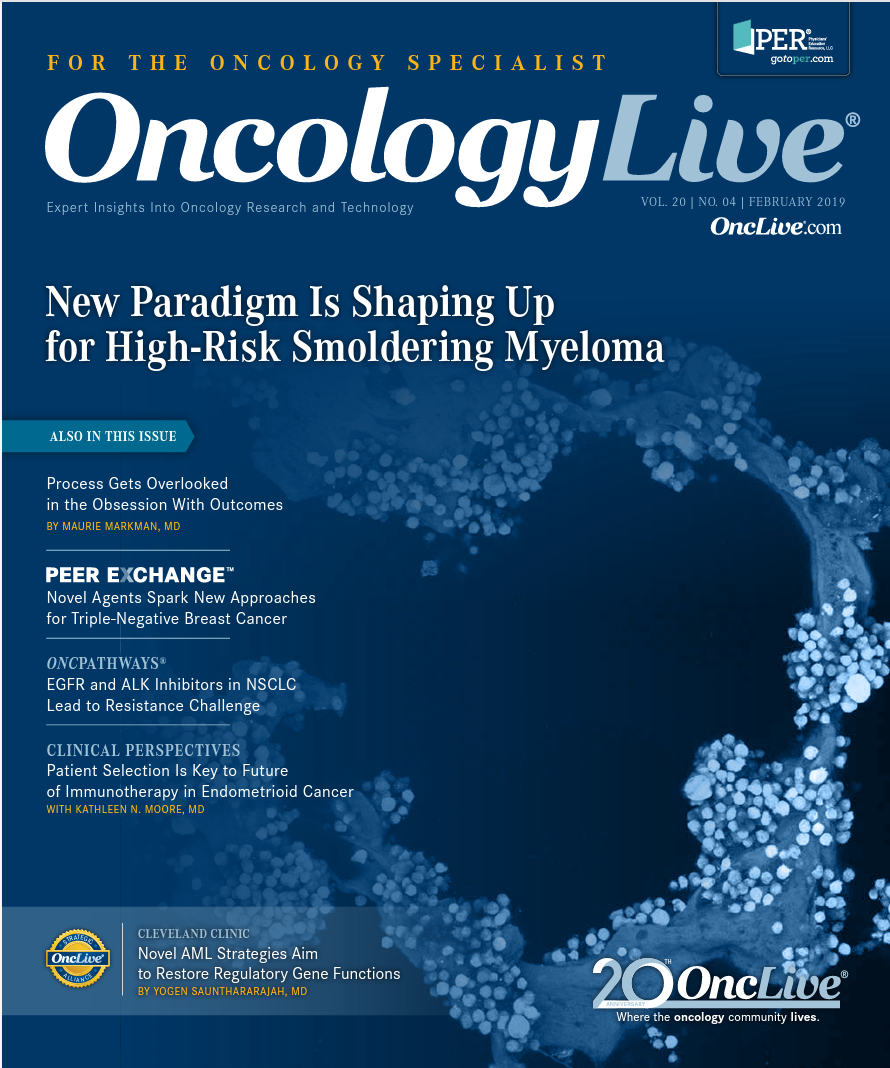Publication
Article
Oncology Live®
Process Gets Overlooked in the Obsession With Outcomes in Oncology
Author(s):
It is essential to appreciate that precision cancer medicine is a process, not an event.

Maurie Markman, MD
It is not difficult to identify multiple examples of the success of precision cancer medicine. One can begin with the decades-old observation that patients with breast cancer whose malignancies overexpress the estrogen receptor are appropriate candidates for antiestrogen therapy, followed by the knowledge that a mutation in the catalytic domain of EGFR is a biomarker for patients with lung cancer who should receive an EGFR inhibitor. Further, BRAF mutations are key to determining who among those with metastatic melanoma may benefit from an inhibitor of this target.
However, these and numerous other success stories have had the unfortunate effect of emphasizing outcomes rather than the important processes through which results can be obtained.
An example of this phenomenon is a randomized phase II trial in France that compared standard chemotherapy of physician’s choice with matched molecularly targeted agents in patients with refractory cancer across tumor types.1 When the study results revealed no difference in outcomes between the 2 study arms, the investigators stunningly and inappropriately declared this was evidence that “off-label use of molecularly targeted agents should be discouraged.” In fact, the study revealed the exact opposite.
It is essential to appreciate that precision cancer medicine is a process, not an event, and this study directly illustrates the importance of this process in cancer medicine. The trial tested the hypothesis that these specific drugs (11 in the experimental arm) could effectively target and subsequently favorably interfere with the negative consequences of defined molecular abnormalities considered to be drivers for cancer progression in this patient population.
The appropriate conclusion for this study should have been one of the following: (a) these agents or the selected dose/ schedules tested do not meaningfully diminish the negative influence of the molecular targets; (b) affecting the molecular target itself does not alter the progression of the cancer (it is not a driver abnormality); (c) the design of the study, which included multiple antineoplastic drugs and several hypothesized molecular targets or pathways, was simply inadequate to objectively evaluate the utility of individual drugs against their molecular targets; or (d) a combination of these factors.
In the future, investigators may elect to explore the potential that an alternative trial design may yield a different result, but it is the search for an approach to favorably impact a valid molecular target that needs to be highlighted rather than the failure of this specific effort to reach a positive outcome.
It is not difficult to find other meaningful examples where a negative conclusion in the evaluation of the utility of a specific molecular biomarker underscores the relevance of the process of precision cancer medicine.
Investigators examining the clinical utility of adding atezolizumab (Tecentriq) to standard-of-care cytotoxic chemotherapy (carboplatin plus etoposide) in the treatment of extensive- stage small cell lung cancer explored the potential that the “number of mutations per megabase of tumor” would be predictive of the patients most likely to benefit from the inclusion of the checkpoint inhibitor in the therapeutic regimen.2 The addition of atezolizumab improved both overall and progression-free survival (PFS), and in this study, the prespecified level of measured tumor mutations was not predictive of benefit with atezolizumab.
Is this a failure of “precision cancer medicine”? The answer is, unquestionably, no. Again, what this provides is another relevant example of the utility of this paradigm-changing exploratory process.
Will future investigation ultimately discover a relevant biomarker that will meaningfully predict for the benefits of employing atezolizumab or other immunotherapeutic strategies in the management of small cell lung cancer? The answer to this question depends on the outcome of studies addressing this critically relevant point; however, it is virtually certain that efforts to be more precise in the delivery of therapy in this setting will become an essential component of clinical research.
For a final example of the value of negative outcomes in the precision cancer medicine process, we turn to the utility of antineoplastic agents developed to interfere with the biological activity of PARP in the management of epithelial ovarian cancer. Although both clinical and preclinical data have strongly supported the value of this class of agents in women with known germline or somatic mutations in BRCA, it has been hypothesized that other molecularly relevant defects within certain ovarian cancers might also predict for a patient population with a normal BRCA network who could benefit from delivery of this class of drugs.
As widely anticipated, in a phase III randomized trial examining the utility of the PARP inhibitor, niraparib (Zejula), employed as a second-line or later maintenance strategy following a response to platinum-based chemotherapy, patients with a documented BRCA mutation exhibited the greatest benefit, measured by improved PFS, from delivery of this agent.3 Further, cancers that did not have such a mutation but were scored as being positive for the presence of a proprietary molecular biomarker measuring other mechanisms of deficient DNA repair exhibited a reduced but statistically significant improvement in this relevant survival outcome.
However, returning to the main point, in this study cancers without a BRCA mutation that were classified as being negative for the proposed biomarker were also shown to exhibit a statistically significant favorable PFS outcome following niraparib delivery. As a result, when niraparib was ultimately approved for routine commercial use in this clinical setting, there was no requirement that therapy be directed by the presence or absence of any biomarker. Although some might quite inappropriately conclude this outcome is an example of the failure of precision medicine, the reality is that the result focuses attention on the critical value of the process itself.
References
- Le Tourneau C, Delord J-P, Goncalves A, et al; SHIVA investigators. Molecularly targeted therapy based on tumour molecular profiling versus conventional therapy for advance cancer (SHIVA): a multicentre, open-label, proof-of-concept, randomized, controlled phase 2 trial. Lancet Oncol. 2015;16(13):1324-1334. doi: 10.1016/S1470-2045(15)00188-6.
- Horn L, Mansfield AS, Szczesna A, et al; IMpower133 Study Group. First-line atezolizumab plus chemotherapy in extensive-stage small-cell lung cancer. N Engl J Med. 2018;379(23):2220-2229. doi: 10.1056/NEJMoa1809064.
- Mirza MR, Monk BJ, Herrstedt J, et al; ENGOT-OV16/NOVA Investigators. Niraparib maintenance therapy in platinum-sensitive, recurrent ovarian cancer. N Engl J Med. 2016;375(22):2154-2164. doi: 10.1056/NEJMoa1611310.



























%20(2)%201-Recovered-Recovered-Recovered-Recovered-Recovered-Recovered-Recovered-Recovered-Recovered-Recovered-Recovered-Recovered-Recovered-Recovered-Recovered-Recovered-Recovered.jpg?fit=crop&auto=format)
%20(2)%201-Recovered-Recovered-Recovered-Recovered-Recovered-Recovered-Recovered-Recovered-Recovered-Recovered-Recovered-Recovered-Recovered-Recovered-Recovered-Recovered-Recovered.jpg?fit=crop&auto=format)
